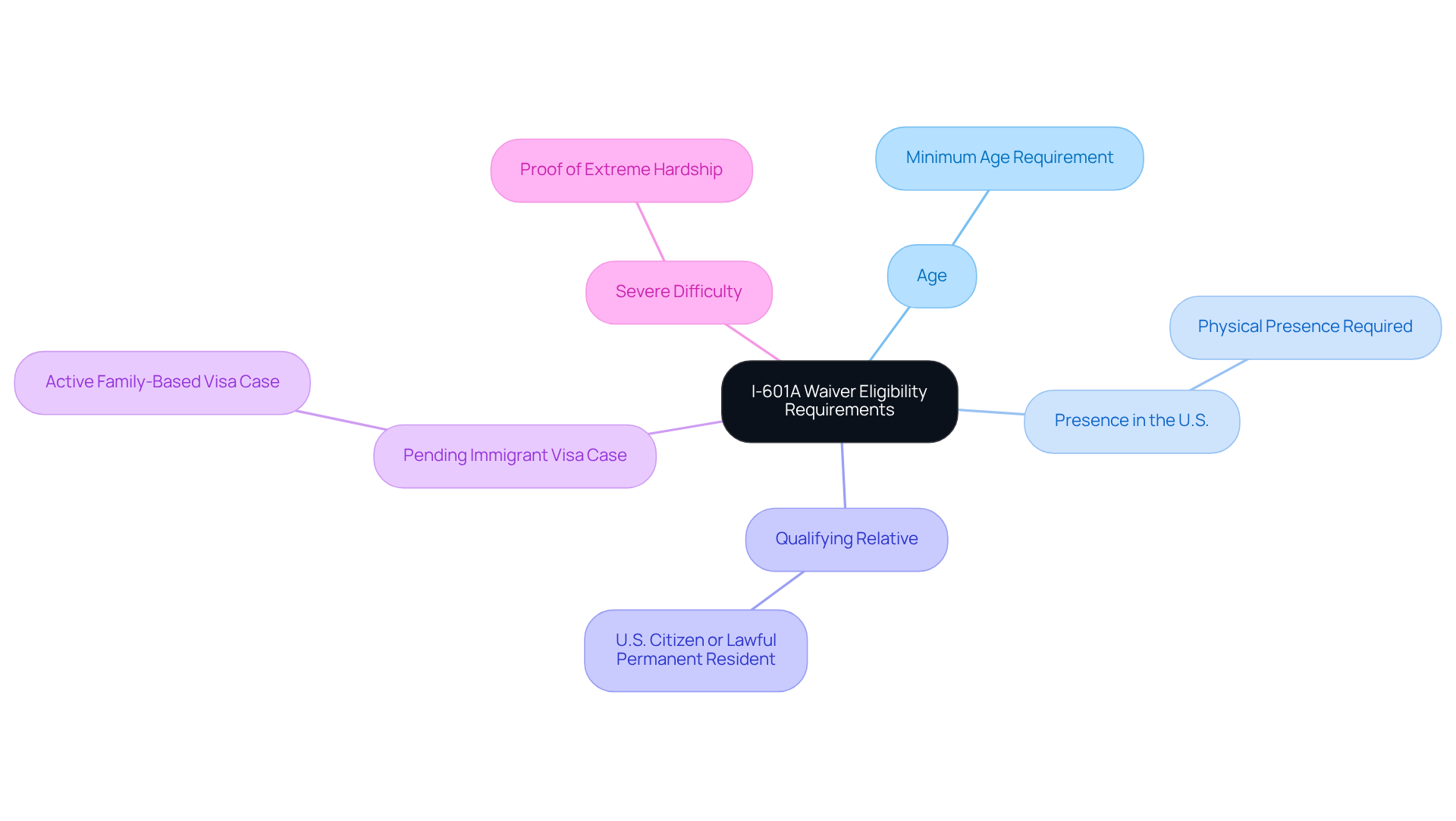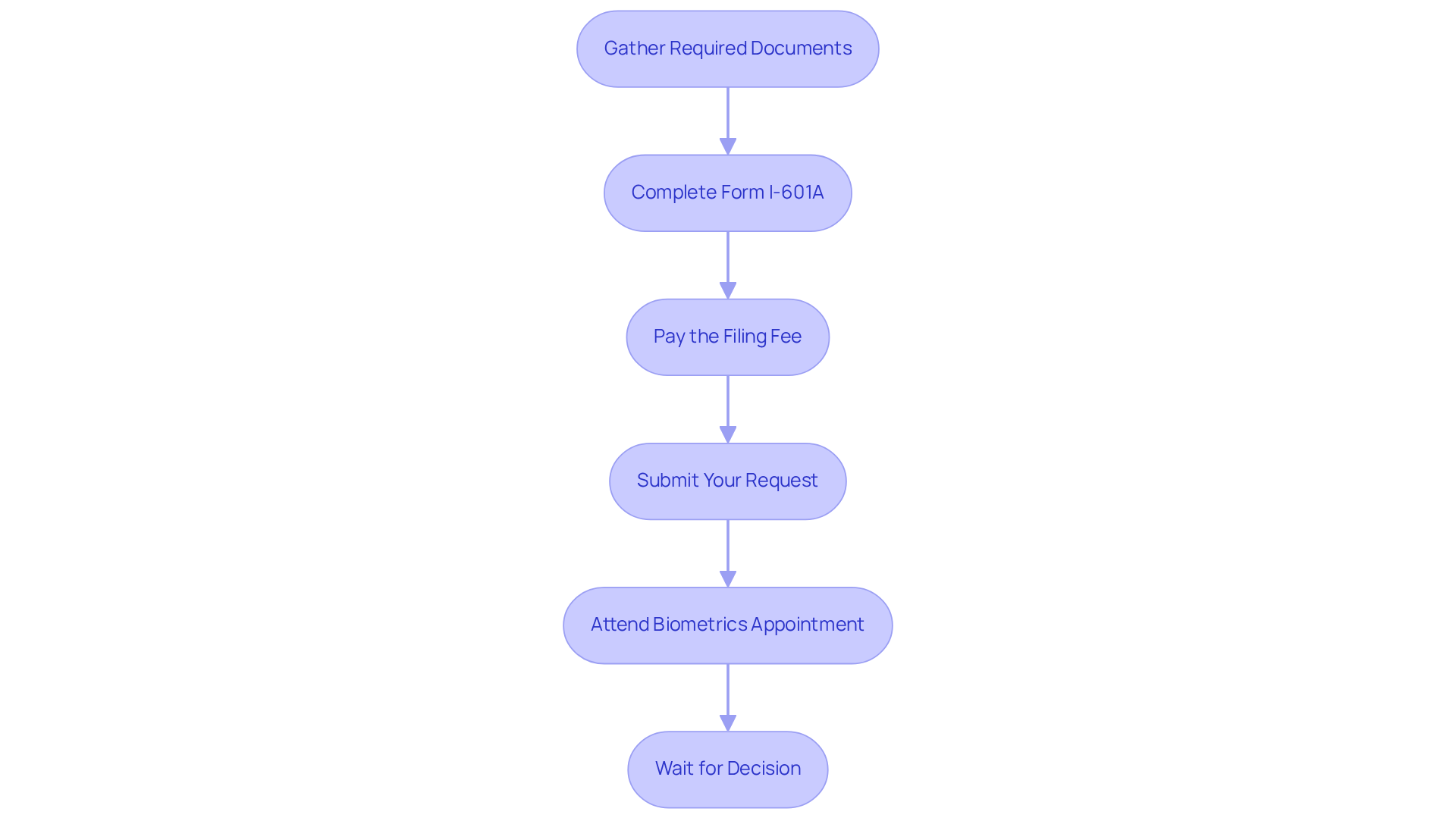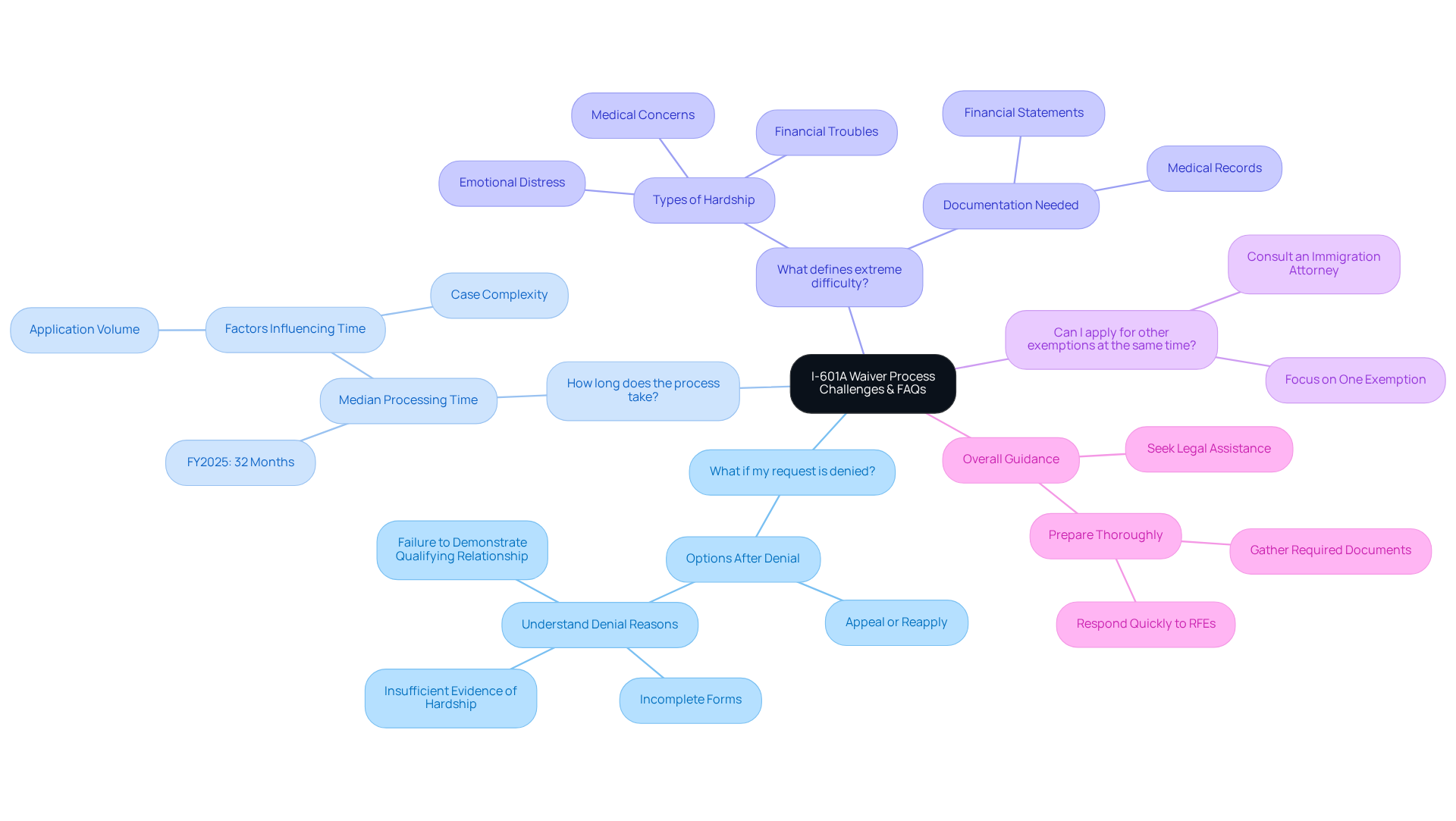Introduction
Navigating the complexities of U.S. immigration law can feel overwhelming, especially when it comes to the I-601A waiver. This waiver is a vital lifeline for individuals facing the threat of family separation. It allows eligible applicants to stay in the country while their immigration cases are processed, offering a crucial chance to keep families together during tough times.
But here’s the reality: even with an approval rate nearing 90%, securing this waiver isn’t easy. It demands careful preparation and a clear understanding of the process. So, what steps do you need to take to successfully navigate this intricate journey? How can you effectively demonstrate the extreme hardship that’s essential to your case?
We understand how overwhelming this feels. You’re not alone in this fight—we’re here to guide you every step of the way.
Overview of the I-601A Waiver and Its Importance
The I-601A exemption, officially known as the Application for Provisional Unlawful Presence Exemption, plays a vital role for individuals in the U.S. who are trying to navigate the complexities of immigration law. This exemption is crucial because it allows qualified candidates to remain in the U.S. while their application is processed, significantly reducing the often painful family separations that can occur during consular processing. By securing this exemption, applicants can avoid the lengthy separations typically required when they must leave the U.S. to apply for an immigrant visa.
Recent statistics show that the approval rate for the I-601A exemption has climbed to around 90%, depending on the strength of the application and the demonstration of extreme hardship to a qualifying U.S. relative. This increase underscores the exemption's importance in immigration law, providing a pathway for families to stay together during the often challenging and drawn-out immigration process.
Consider the impact of this exemption on family dynamics. One case involved a father who was the primary caregiver for his wife, who suffered from a chronic illness. His absence would have severely disrupted her medical treatment and their children's education, leading to a successful application for relief based on the demonstrated extreme hardship.
The process for this immigration relief has also evolved, emphasizing the need for thorough documentation. USCIS has heightened scrutiny of hardship claims, requiring applicants to present detailed medical, financial, and psychological evidence to support their cases. This reflects the changing landscape of immigration policy and the importance of being prepared.
Understanding the I-601A exemption, known as the perdón i 601, is essential for those facing the complexities of immigration law. It not only fosters family unity but also serves as a crucial legal tool for individuals dealing with inadmissibility due to unlawful presence, specifically through the 'perdón i 601'. Remember, you’re not alone in this fight—we’re here to support you every step of the way.

Eligibility Requirements for the I-601A Waiver
To qualify for the I-601A exemption, applicants must meet several essential requirements:
- Age: You need to be at least 17 years old when you file your application.
- Presence in the U.S.: You must be physically present in the United States when you submit your request.
- Qualifying Relative: A qualifying relative, like a U.S. citizen or lawful permanent resident spouse or parent, is necessary.
- Pending Immigrant Visa Case: There must be an active immigrant visa case based on a family relationship.
- Severe Difficulty: You must convincingly show that your qualifying relative would face severe difficulty if the exemption isn’t approved.
Understanding these criteria is crucial for assessing your eligibility for the perdón i 601 and for preparing your submission effectively. Current trends indicate that acceptance rates for well-organized applications can soar to 90%, especially when they clearly demonstrate the required severe difficulties. For example, cases where the qualifying relative depends on you for critical support—like medical care or financial stability—have seen successful outcomes.
Family-based immigration represents about 40% of new green card holders each year. Therefore, ensuring that all your documentation is complete and accurate is vital to avoid delays or denials. Remember, you’re not alone in this process; we’re here to fight for your family.

Step-by-Step Application Process for the I-601A Waiver
Navigating the I-601A waiver application process, particularly the perdón i 601, can feel overwhelming, but you’re not alone. Here’s a straightforward guide to help you through each essential step:
-
Gather Required Documents: Start by collecting all necessary documentation. This includes proof of your qualifying relationship and evidence of extreme hardship. Think financial records, medical documents, and personal statements—anything that tells your story.
-
Complete Form I-601A: Take your time filling out the I-601A submission form. Accuracy is key here. Double-check all information to avoid delays caused by errors or omissions.
-
Pay the Filing Fee: Don’t forget to include the filing fee with your submission. Right now, it’s set at $795.
-
Submit Your Request: Once everything is ready, send your completed form along with all supporting documents to the designated USCIS address.
-
Attend Biometrics Appointment: After you submit, you’ll receive a notice for a biometrics appointment. This is where your fingerprints will be collected, and it usually lasts about 15 to 30 minutes.
-
Wait for Decision: Finally, USCIS will review your application and notify you of their decision. Keep in mind that the typical processing time is around 32 months, with a median processing period of 43.5 months. The success rate for the I-601A application generally falls between 70% and 80%, depending on how strong your case is.
By following these steps closely, you can significantly boost your chances of a successful waiver request. Remember, demonstrating 'extreme hardship' for your qualifying relative is crucial for approval. Common pitfalls include submitting incomplete forms and not responding quickly to Requests for Evidence (RFEs). These mistakes can lead to unnecessary delays or even denials.
If your exemption under perdón i 601 is denied, don’t lose hope. While you can’t contest that decision, you can submit a traditional Form I-601 after your immigrant visa interview.
We’re here to fight for your family. Your future matters to us.

Common Challenges and FAQs in the I-601A Waiver Process
Navigating the perdón i 601 exemption process can be tough. Many applicants face challenges that can feel overwhelming. Here are some common issues and frequently asked questions that might help you find your way:
-
What if my request is denied? If your waiver is denied, don’t lose hope. You may have the option to appeal or reapply. Understanding why your request was denied is crucial. Addressing these issues in future applications can significantly boost your chances of success. Common reasons for denial include insufficient evidence of extreme hardship, incomplete forms, and failure to demonstrate a qualifying relationship.
-
How long does the process take? The processing time for the I-601A waiver can vary. For FY2025, the median processing time is about 32 months. Be prepared for potential delays; factors like application volume and the complexity of individual cases can influence timelines.
-
What defines extreme difficulty? Extreme challenges might include financial troubles, medical concerns, or emotional distress that a qualifying relative would face if the exemption isn’t approved. It’s essential to provide comprehensive documentation, such as medical records and financial statements, to substantiate claims of hardship.
-
Can I apply for other exemptions at the same time? It’s generally best to focus on one exemption request at a time to avoid complications. However, consulting with an immigration attorney can clarify your specific situation and help determine the best course of action.
Understanding these challenges and having answers to common questions can empower you to navigate the perdón i 601 waiver process more effectively. By preparing thoroughly and seeking legal guidance, you can enhance your chances of a successful outcome. Remember, you’re not alone in this fight—we’re here to support you every step of the way.

Conclusion
The I-601A waiver, or the Application for Provisional Unlawful Presence Exemption, is a vital lifeline for those grappling with the complexities of U.S. immigration law. It allows qualified applicants to stay in the U.S. while their immigrant visa applications are processed, significantly reducing the painful family separations that often come with consular processing. For anyone facing inadmissibility due to unlawful presence, understanding the I-601A waiver is crucial. It not only fosters family unity but also opens a pathway to legal residency.
Throughout this article, we’ve shared essential insights about:
- Eligibility requirements
- The step-by-step application process
- The common challenges applicants face
It’s critical to demonstrate extreme hardship to a qualifying relative for a successful application. With approval rates soaring to around 90% for well-prepared submissions, the importance of thorough documentation and understanding procedural nuances cannot be overstated. Addressing frequently asked questions also sheds light on concerns many applicants share, empowering them to navigate the process more effectively.
The journey through the I-601A waiver process can feel overwhelming, but it’s vital for those wanting to keep their families together amid immigration hurdles. Staying informed and prepared can significantly enhance your chances of success. Seeking legal guidance and support can further strengthen your case. The significance of the I-601A waiver goes beyond individual situations; it embodies hope and resilience for families striving to overcome the challenges of immigration law.
Remember, you’re not alone in this fight. We’re here to support you every step of the way. Your future matters to us, and together, we can navigate these challenges.
Frequently Asked Questions
What is the I-601A waiver?
The I-601A waiver, officially known as the Application for Provisional Unlawful Presence Exemption, allows qualified individuals in the U.S. to remain in the country while their immigrant visa application is processed, reducing family separations during consular processing.
Why is the I-601A waiver important?
The I-601A waiver is important because it helps families stay together during the immigration process, avoiding lengthy separations that can occur when individuals must leave the U.S. to apply for an immigrant visa.
What is the approval rate for the I-601A waiver?
The approval rate for the I-601A waiver has climbed to around 90%, depending on the strength of the application and the demonstration of extreme hardship to a qualifying U.S. relative.
Can you provide an example of how the I-601A waiver has impacted family dynamics?
One example involved a father who was the primary caregiver for his chronically ill wife. His absence would have severely disrupted her medical treatment and their children's education, leading to a successful application for relief based on demonstrated extreme hardship.
What documentation is required for the I-601A waiver application?
Applicants must provide thorough documentation, including detailed medical, financial, and psychological evidence to support their claims of extreme hardship, as USCIS has heightened scrutiny of hardship claims.
What does the term "perdón i 601" refer to?
"Perdón i 601" refers to the I-601A exemption, highlighting its role in providing relief for individuals dealing with inadmissibility due to unlawful presence.




